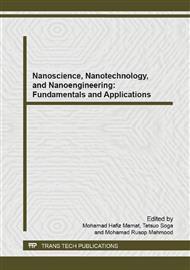p.223
p.227
p.232
p.238
p.243
p.248
p.253
p.257
p.262
Controlled Growth of WO3-Loaded TiO2 Nanotubes for Tandem Solar-Driven Water Splitting Cell
Abstract:
Nowadays, hydrogen production using solar-driven photoelectrochemical (PEC) water splitting has attracted considerable attention since the introduction of TiO2 photoelectrodes. However, TiO2 is not able to split water on its own because the cleavage requires more than 1.4 V or even up to 1.9 V, including the redox potential of water (1.23 V) and unavoidable over-potentials. Many semiconductors have been studied, but only a very few large band gap materials can generate enough photo-voltage to cleave water for a single photoelectrode PEC water splitting cell especially processing under solar illumination. In the present study, development of WO3-loaded TiO2 nanotubes (WTNT) is a possible solution to generate a voltage that is high enough to split the water while absorbing more light (photons) from a greater part of solar spectrum. Furthermore, WTNT offered several advantages over the pure TiO2 photoelectrode, such as excellent chemical and thermal stability, active at room temperature as well as responsive to UV and visible illumination. The paper concludes by presenting the comparison results between unmodified TiO2 and WTNT photoelectrode in term of morphology, phase, elemental analysis, electrical properties, and electrochemical properties for the tandem solar-driven water splitting cell.
Info:
Periodical:
Pages:
243-247
Citation:
Online since:
June 2015
Authors:
Keywords:
Price:
Сopyright:
© 2015 Trans Tech Publications Ltd. All Rights Reserved
Share:
Citation:


